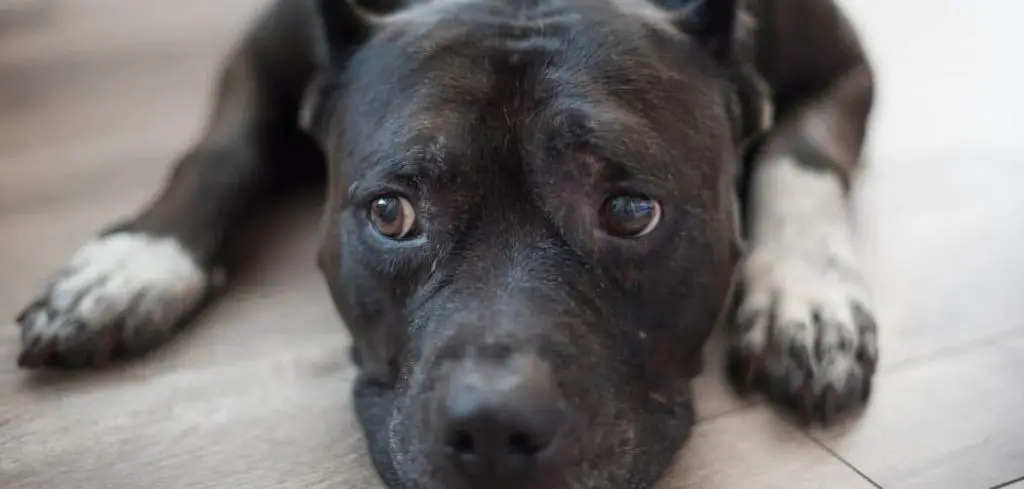If your dog is lethargic not eating or drinking and shaking, these symptoms combined can indicate a serious underlying condition. While each of these signs—fatigue, appetite loss, and tremors—can sometimes occur in isolation due to mild issues like stress or cold, their combination usually signals something more urgent.
We guide you through what could be causing these symptoms, what you can do at home, and when to seek immediate veterinary care.
Dog Lethargic, Not Eating or Drinking Shaking: Why It Happens
When your dog is lethargic not eating or drinking and shaking, it may be due to acute pain, poisoning, severe infections, low blood sugar, kidney failure, or neurological conditions. These symptoms often signal a system-wide problem affecting your dog’s metabolism, hydration, and nervous system.

Dog Lethargic Not Eating or Drinking Shaking: Common Causes
Toxic Ingestion or Poisoning
Toxins—whether from household items, medications, or certain foods—can cause sudden shaking, nausea, lethargy, and complete loss of appetite.
Signs of poisoning may include:
Drooling or vomiting
Disorientation or wobbling
Seizures or muscle tremors
Collapse or unconsciousness
Common culprits include chocolate, xylitol, rat poison, grapes, and some human meds. If you suspect your dog ingested something toxic, contact your vet or pet poison control immediately.
Hypoglycemia (Low Blood Sugar)
Low blood sugar is particularly dangerous in puppies and small breeds but can affect any dog under stress, illness, or lack of food. Symptoms can include:
Weakness or disorientation
Full-body trembling or shivering
Lethargy
Seizures in severe cases
Quick intervention with sugar (like honey on the gums) can stabilize your dog temporarily—but professional treatment is still essential.
Related: My dog is lethargic and not eating (Causes and when to worry)
Pain or Physical Injury
A dog in pain may shake and refuse to eat or drink. Injuries from falls, arthritis flare-ups, or even abdominal pain can lead to:
Trembling
Guarded posture or yelping
Disinterest in food and water
Slow or unsteady movement
Pain medication and diagnostic tests (like X-rays) from your vet can help identify and relieve the source of pain.
Fever or Severe Infection
Dogs fighting a systemic infection—like parvovirus, leptospirosis, or tick-borne illnesses—often become lethargic, stop eating, and shake due to chills or fever.
Watch for:
High body temperature
Vomiting or diarrhea
Nasal discharge or coughing
Swollen lymph nodes
Your vet may recommend bloodwork, IV fluids, antibiotics, and close monitoring.
Kidney Failure
Acute or chronic kidney disease can make a dog feel sick, refuse water and food, and cause trembling due to toxin buildup in the bloodstream.
Symptoms include:
Nausea or vomiting
Increased or decreased urination
Bad breath (ammonia-like)
Weakness and shaking
Kidney issues require blood tests and often fluid therapy, special diets, and long-term care.
Neurological Issues or Seizure Activity
If your dog is trembling and showing signs of lethargy and appetite loss, it could point to a neurological problem like epilepsy, vestibular disease, or a brain tumor.
Signs may include:
Head tilting or circling
Uncoordinated walking
Muscle twitching or full-body tremors
Confusion or staring spells
Neurological evaluation and imaging (such as MRI or CT) may be necessary for diagnosis.
Extreme Fear or Stress Response
While emotional stress usually causes only temporary symptoms, severe anxiety or trauma (e.g., from a loud event or separation anxiety) can cause:
Shaking
Panting
Lethargy and hiding
Avoiding food and water
Creating a calm environment and using calming aids may help, but persistent symptoms should be evaluated by a vet.
What to Do
Here are practical steps you can take right away:
Keep your dog warm and calm – Trembling may be due to pain, stress, or chills.
Offer small amounts of water or broth – Avoid forcing it if they’re resistant.
Avoid giving any human medication – These can worsen the situation.
Note all symptoms and when they began – This will help your vet make a fast diagnosis.
Check gums and body temperature – Pale gums and a high or low temp require immediate attention.
These symptoms together should never be ignored. Monitor closely and prepare for a vet visit.
When to Call or Visit Your Vet
You should call or visit your vet immediately if:
Shaking is severe or ongoing
Your dog hasn’t eaten or drunk anything for over 12–24 hours
Lethargy is profound or your dog is unresponsive
You suspect poisoning or toxin exposure
Vomiting, diarrhea, or seizures are present
Early intervention could be lifesaving—don’t wait and hope the symptoms pass on their own.
Related: My dog is drooling and lethargic (Here’s why)
Key Takeaway
If your dog is lethargic not eating or drinking and shaking, it’s a serious situation that may point to poisoning, infection, pain, or neurological dysfunction.
While it’s scary to see your dog so unwell, acting quickly can dramatically improve the outcome.
Don’t delay—reach out to your vet, document symptoms, and stay calm. Your fast action and attention could make all the difference.
